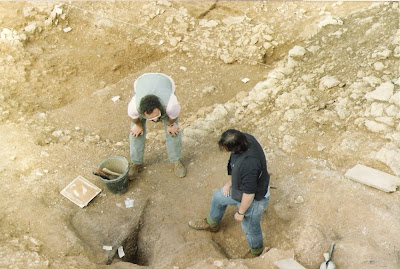Tuesday, March 31, 2009
View from the Cotswold Hills near Birdlip, Gloucestershire
Monday, March 30, 2009
Delivering the tools ...
Sunday, March 29, 2009
Stop press ...
Wheelbarrows or deckchairs?
Saturday, March 28, 2009
This month's prize winning entry ...
Friday, March 27, 2009
Was there a Savage response?
Thursday, March 26, 2009
Crickley Hill Man in a hole ...
Wednesday, March 25, 2009
Sometimes we all just needed to have a lie down ...
Tuesday, March 24, 2009
Stop standing about and do some digging!
Monday, March 23, 2009
Taking the baulk back to the bedrock
Sunday, March 22, 2009
The Second Hillfort
Not sure what Jane had done to merit this ...
Saturday, March 21, 2009
CH 1980 bailing out the cuttings again ...
Friday, March 20, 2009
Another lunchtime portrait
Thursday, March 19, 2009
CH 83 - the Scrungers
Wednesday, March 18, 2009
Experimental archaeology 6: a watched pot never fires ...
Tuesday, March 17, 2009
CH 1990 looking south to the hilltop
Monday, March 16, 2009
Arwell's jacket: Constable could have painted this ...
Sunday, March 15, 2009
CH85: low level conference
Saturday, March 14, 2009
Fourth Report, 1972: part IV
The Period 2 hollow way narrowed where it ran between Houses 1 and 2, and came no closer than 1.5m to the lines of posts. The traffic was presumably here being funnelled by a barrier, and it thus seems likely that the outer walls of the houses lay the beyond the lines of the post holes, which thus formed internal supports of the roof structure. Absence of post holes for such an outer wall creates no difficulties, for the problems, experimentally observed, during the course of our excavations, of cutting small post holes in the oolite might well induce even builders accustomed to earth-fast posts to rely on walling framed on sleeper beams. In House 5 two post holes in this outer position can be seen as additional evidence for a framed exterior wall: House 5 had no other postholes in this position and the two outer holes perhaps supported a special structure -- the largest house having the most imposing facade. Between House 1 and House 3 a small square structure with a central posthole, perhaps to support a raised floor, projected beyond the lines of postholes into the roadway. As can be seen in figure 6, however, the proposed outer walls of Houses 1 and 3 aligned with the south wall of this square structure, which thus continued the line of the street frontage.
Suggested reconstructions of the longhouses are shown in figure 7. The simplest method would probably have been to fit horizontal timbers (aisle plates) between the aisle posts on the longitudinal axes of the houses; as at Stonehenge, a plain mortice-and-tenon joint would suffice to join aisle post to aisle plate. Reconstruction 2 shows one such interpretation with the addition of a substantial outer turf wall to support the ends of a common rafter roof. Considerable quantities of burned daub from wattling were found around the houses and in the postholes. This suggests that the outer walls were merely wattled screens, but these could conveniently have been framed on sleeper beams and could, even without earth-fast posts, have supported considerable weight. But it is noticeable that the post-settings are paired symmetrically, and this suggests an alternative more complex upper structure. The aisle posts could have been held together by tie-beams across the width of the house and the roof supported on couples at about 10’ centres. Such a structure - a principal rafter roof - is shown in Reconstruction 1 and in the perspective and axonometric drawings in figure 7. Further elaboration of the roof structure is too hypothetical, but could include bracing and crown posts on the tie-beams.
The hollow way continued as far as the end of the second bay of houses one and two. No further trace of it could be found, and it is therefore possible that the entrances to these longhouses were lateral (see cover drawing). At the east end of House 4 an additional posthole, 811, may have been for a gable door. Apart from a streak of burning which might indicate that a porch stood on the north side of bay five in House 5, there was no other evidence for door positions, and there is so far very little trace of the subdivisions that are found in comparable structures on the continent of






.jpg)





















